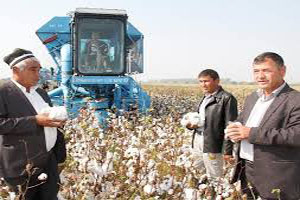
Tajikistan focus to raise cotton yield as it reduces acreage
YarnsandFibers News Bureau 2015-02-27 11:00:00 – SUGHD PROVINCE, TajikistanTajik cotton farmers focusing on increasing its cotton yields for which they are trying out more productive foreign seeds, even as it reduces the acreage devoted to the water-intensive crop.
In the interest of crop diversity and due to ecological concerns, the country's farmers have reduced the farmland planted under cotton by more than 26,000ha to 177,624ha between 2011 and 2014. Over the same period, nationwide cotton production dropped from 415,000 tonnes to 372,000 tonnes per year.
The Tajik textile and other cotton-using industries face the prospect of lacking raw material, so authorities are seeking ways to increase yield. One option is to seek out more productive cotton varieties, domestic or imported.
In the past, they used to rely only on Central Asian scientific achievements, said Dushanbe-based agricultural scientist Dr. Alichon Normatov. Now their integration into the world economy allows them to benefit from foreign cotton growers' experience.
In 2013, some farmers in Khatlon and Sughd provinces experimentally planted domestic and foreign cotton side by side to compare yields. The foreign varieties had 2.3- to 3.3-fold higher yields per hectare than domestic ones.
Certain farms harvested 4 to 5.5 tonnes of cotton per ha [compared to about 2 tonnes per ha for domestic seeds], said Muhammadi Ormonov, head of the Agriculture Ministry's Horticulture Department. In 2014, they advised cotton growers to more actively use imported cotton varieties that suit their conditions. The results met their expectations.
One year later, in Sughd Province in 2014, farmers devoted a third of their cotton acreage to foreign seeds. That third accounted for a majority of the cotton harvested in the province – almost 53,000 of more than 97,000 tonnes, according to the provincial Agriculture Department.
Some of the top-performing seed varieties came from Brazil, Bulgaria and Turkey.
Encouraged by that result, Sughd Province farmers this year are expected to plant foreign cotton seeds in 39,000 of 54,000 irrigated hectares set aside for cotton.
One of the farmers who saw high yields is Shukhrat Rakhmonov of Asht District, Sughd Province. Last year he leased 10ha of land and planted it with Turkish cotton. He harvested 4.1 tonnes per hectare.
Encouraged by that result, he plans to double the land leased this year and to try Australian seeds, which have been known to succeed in Sughd Province's land and climate.
This [Australian] variety's chief merits are that … its seeds ripen simultaneously, which makes the harvesters' work much easier, and the fibre content is high. In addition, land in Asht District is rather dry ... so the most drought- and pest-resistant Australian variety was chosen. He is now ready to help other farmers by selling them the high-performance seeds on credit.
Cotton will remain the country's number one crop, if farmers learn to embrace the latest technology and scientific achievements, their incomes can increase because of higher yields, said Ormonov of the Agriculture Ministry.
Tajikistan besides exporting cotton, has a domestic textile industry that depends on the farmers. Even though the country's 21 cotton fibre processing factories functioned at only 14.2% of capacity in 2014, the government is working to revitalize industry.
The government plans restoring Khujand's largest textile factory, Kaobol Tajik Textiles, capable of processing up to 30,000 tonnes of cotton fibre per year.
Tajikistan also plans to build textile plant in Danghara District, Khatlon Province, capable of producing 52,000 tonnes of yarn annually. The first phase of the factory – a spinning mill able to produce 6,000 tonnes of yarn per year – is scheduled to begin operation in 2015. Swiss and Italian firms are co-financing the project, said Bakokhon Khotamov, head of the Industry Ministry's Light Industry and Cocoon Production Department.
The new industrial giant with a full production cycle will be able to process half of the cotton fibre to be extracted from Khatlon Province's cotton harvest. So farmers won't have to worry about where to export their cotton.
Market Intelligence
Ask for free sample Report

experience
Customer Base
dedicated team
Countries Served Worldwide









